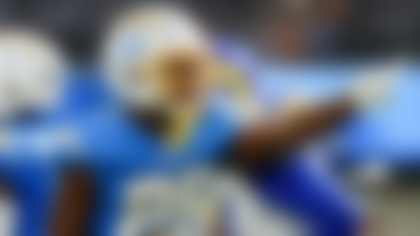Television, radio and the print media might have talked about all the events, rumors and conjecture leading up to the Super Bowl to the point that there was nothing left to talk about. But the coaches and scouts watched the game tapes -- especially of the previous playoff games -- and built a game plan around the facts that were on the screen.
Let's take a look at how the game plans held up, especially for the world champion Colts.
Rex Grossman couldn't get the deep completion he wanted against Indy.
1. THE BEARS OFFENSE ON FIRST DOWNS.
Throughout the playoffs, the Bears had demonstrated success throwing the ball on first downs, and the Colts knew it. Everywhere you turned, you heard someone saying the Bears need to take some shots down the field on early downs because Bob Sanders will be up in the run-support box. The Colts' computer breakdown told them Rex Grossman had thrown 20 times on first down in the two playoff games and completed 11. What the film study showed them was that Bernard Berrian caught six of those first-down passes at 27 yards per catch and two touchdowns (and a setup of a third score).
The Colts were not going to abandon their run-defense calls with Sanders up in the box -- especially early in the game -- but they were also not going to surrender 27 yards per catch to Berrian. The Bears went to Bernard four times on first downs, but for an 8-yard completion average. The Colts defensive backs gave him all the short passes he wanted, but no shots down the field. And when Grossman tried, it was picked off.
Grossman stuck with the plan to throw on first down throughout the game, and delivered 10 completions in 14 attempts for a modest 83 yards. Both of his interceptions came in the fourth quarter on deep passes on first-and-10. The second time, Sanders just happened to be deep and picked off the pass.
2. WHAT THE BEARS DID AFTER A FIRST-DOWN INCOMPLETION.
Coaches always look at the play-calling style in many situations. During the playoffs, Grossman had a strong run tendency after a first-down incompletion. The Bears had six runs against two passes when it was second-and-10 after an errant throw. The Colts didn't get many chances to use this scouting-report tendency, because they surrendered the first-down short-passing attack and Grossman did not find himself in too many second-and-10 calls. The two times it did occur, the Bears ran the ball with Thomas Jones and threw a very short pass to Jones, which a run-defense call can handle. In both cases, the Bears gained only 2 yards, which set up third-and-long. The scouting report held up again.
3. WHAT THE BEARS DID WHEN FIRST-DOWN RUNS GOT 3 YARDS OR FEWER.
In its first two playoff games, Chicago had 13 first-down run plays that generated 3 yards or less. In fact, the 13 first-down runs that were in this scouting-report segment generated only 13 yards. The question was what Ron Turner would do next if the first-down run call was stuffed. The report came back with this answer: Throw the ball. In those 13 situations, the Bears passed 11 times.
Before the Super Bowl got out of hand, Chicago did not have an occurence where a run created a second-and-7 or longer, so there were no second-down situations in the game when the Colts could use the report about the pass tendency.
For all the people who questioned the Colts defense as too small to stop the Bears running game, the only question is why the Bears didn't run the ball more on first down, especially after Jones gained 52 yards on a first-and-10 early in the game. Cedric Benson's knee injury might have spooked the Bears, or maybe they felt pressure when they fell behind, or maybe they just got away from what they do best.
4. WIN THE TURNOVER BATTLE.
By game's end, the Colts had won the turnover battle 5-3, and now the winner of the turnover battle is 30-3 in Super Bowls. The Bears led the NFL this season with 44 turnovers created and added five more in the NFC playoffs for 49 in 18 games heading into the Super Bowl. In fact, they scored 156 points off turnovers this season, but in the big game, they lost the battle that was so good to them all year.
Forced fumbles is an effort play, but interceptions like the two the Colts had were excellent defensive calls; what made them special was the interception returns. Go back and look at the tapes to see the game plan the Colts had on the 94 yards of interception returns. There was a wall return on both picks; it looked more like a punt return than an interception. Every single Colt got a block on someone. The Colts were more prepared to return the ball than the Bears were to stop them. The Colts played the whole game looking for interceptions and were also trained to score when they got the ball.



